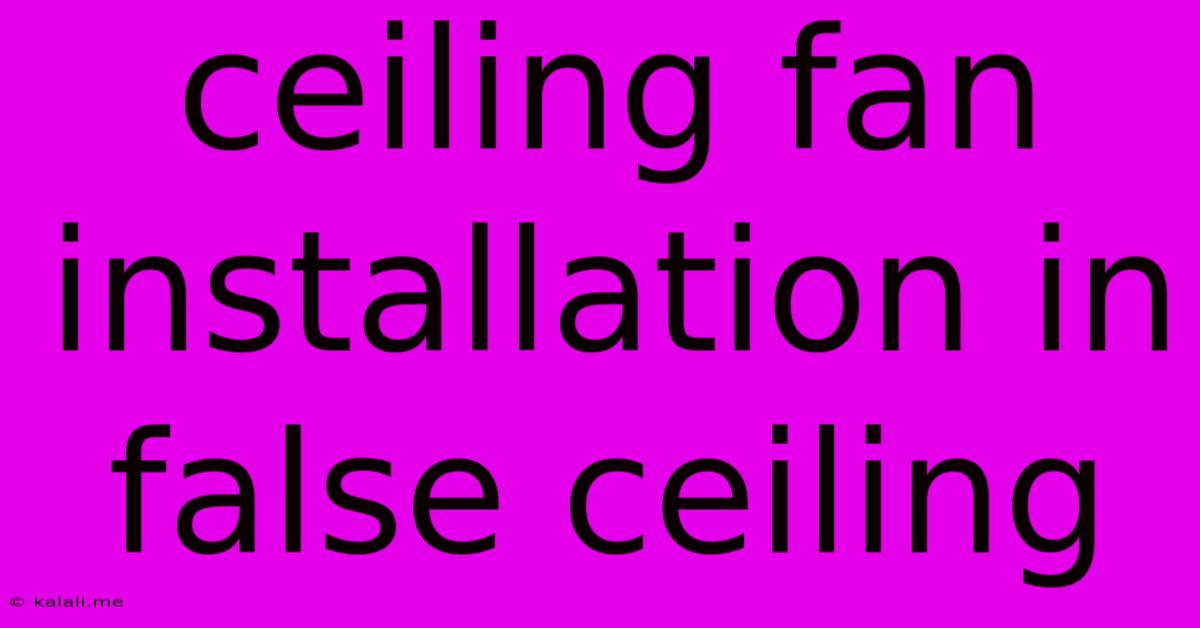Ceiling Fan Installation In False Ceiling
Kalali
Jun 06, 2025 · 3 min read

Table of Contents
Ceiling Fan Installation in a False Ceiling: A Comprehensive Guide
Meta Description: Learn how to safely and effectively install a ceiling fan in a false ceiling. This comprehensive guide covers everything from choosing the right fan to final wiring, ensuring a smooth and successful installation.
Installing a ceiling fan in a false ceiling presents a unique set of challenges compared to installing one in a standard ceiling. However, with careful planning and execution, it's a perfectly achievable DIY project. This guide will walk you through the entire process, from selecting the appropriate fan to completing the final electrical connections. Remember, safety is paramount – if you're unsure about any step, consult a qualified electrician.
1. Choosing the Right Ceiling Fan
The first step is selecting a ceiling fan designed for installation in a false ceiling. Look for fans specifically marketed as suitable for this type of installation. Key features to consider include:
- Downrod Length: The downrod connects the fan motor to the ceiling. You'll need a shorter downrod than usual to accommodate the space between the false ceiling and the structural ceiling. Measure this distance carefully before purchasing.
- Weight Capacity: Ensure the fan's weight capacity is suitable for your false ceiling. A heavier fan may require additional support within the false ceiling structure.
- Motor Size and Power Consumption: Choose a fan with appropriate airflow for the room size, considering the ceiling height and insulation.
- Blade Style and Material: Consider the aesthetic appeal of the fan blades and the overall design to match your interior decor.
2. Preparing for Installation
Before you begin, gather all necessary tools and materials:
- Ceiling Fan: The chosen fan, including all components (motor, blades, downrod, mounting bracket).
- Wiring Supplies: Electrical wire, wire connectors, junction box, and electrical tape.
- Tools: Screwdrivers (Phillips and flathead), wire strippers, voltage tester, level, drill with appropriate drill bits, measuring tape, and safety glasses.
- Support Structure (if needed): Additional support might be required for heavier fans. This could involve adding extra bracing to the false ceiling.
Safety First: Always turn off the power to the circuit at the breaker box before beginning any electrical work.
3. Installing the Mounting Bracket
Carefully locate the joist in your structural ceiling above the false ceiling. This is crucial for secure mounting. You may need to use a stud finder to locate the joist. Once located, create a hole in your false ceiling to access the joist. Securely attach the ceiling fan's mounting bracket to the joist using appropriate screws and fasteners.
4. Wiring the Ceiling Fan
This is the most crucial and potentially dangerous step. Follow the manufacturer's instructions precisely. Carefully connect the wires from your ceiling fan to the house wiring according to the color codes (typically black for hot, white for neutral, and green or bare copper for ground). Use wire connectors to secure each connection and ensure a tight fit. Double-check all connections before proceeding.
5. Attaching the Fan Motor and Blades
Once the wiring is complete, carefully attach the fan motor to the mounting bracket. Then, securely attach the fan blades, following the manufacturer's instructions.
6. Testing and Finishing
After completing the installation, carefully restore power to the circuit at the breaker box. Test the fan to ensure it functions correctly and the blades rotate smoothly. Address any issues immediately. Finally, install any decorative covers or trim to conceal the wiring and mounting hardware.
7. Troubleshooting Common Issues
- Fan Wobble: This usually indicates an imbalance in the blades. Carefully check that the blades are securely fastened and evenly spaced.
- Buzzing Noise: This could be due to loose screws or a problem with the motor. Check all connections and screws.
- Fan Not Working: This often indicates a wiring problem. Double-check all electrical connections and consult the wiring diagram provided with the fan.
By following these steps and prioritizing safety, you can successfully install a ceiling fan in your false ceiling. Remember, if you are uncomfortable with any aspect of this process, it's always best to seek professional help. A properly installed ceiling fan can significantly enhance comfort and aesthetics in your home.
Latest Posts
Latest Posts
-
When An Opponent Loses Life You Gain Life
Jun 06, 2025
-
How To Add Music To Your Ipod Without Itunes
Jun 06, 2025
-
Why Is My Female Dog Licking Everything
Jun 06, 2025
-
Does Olive Oil Solidify In The Fridge
Jun 06, 2025
-
Actors In The Movie John Carter
Jun 06, 2025
Related Post
Thank you for visiting our website which covers about Ceiling Fan Installation In False Ceiling . We hope the information provided has been useful to you. Feel free to contact us if you have any questions or need further assistance. See you next time and don't miss to bookmark.